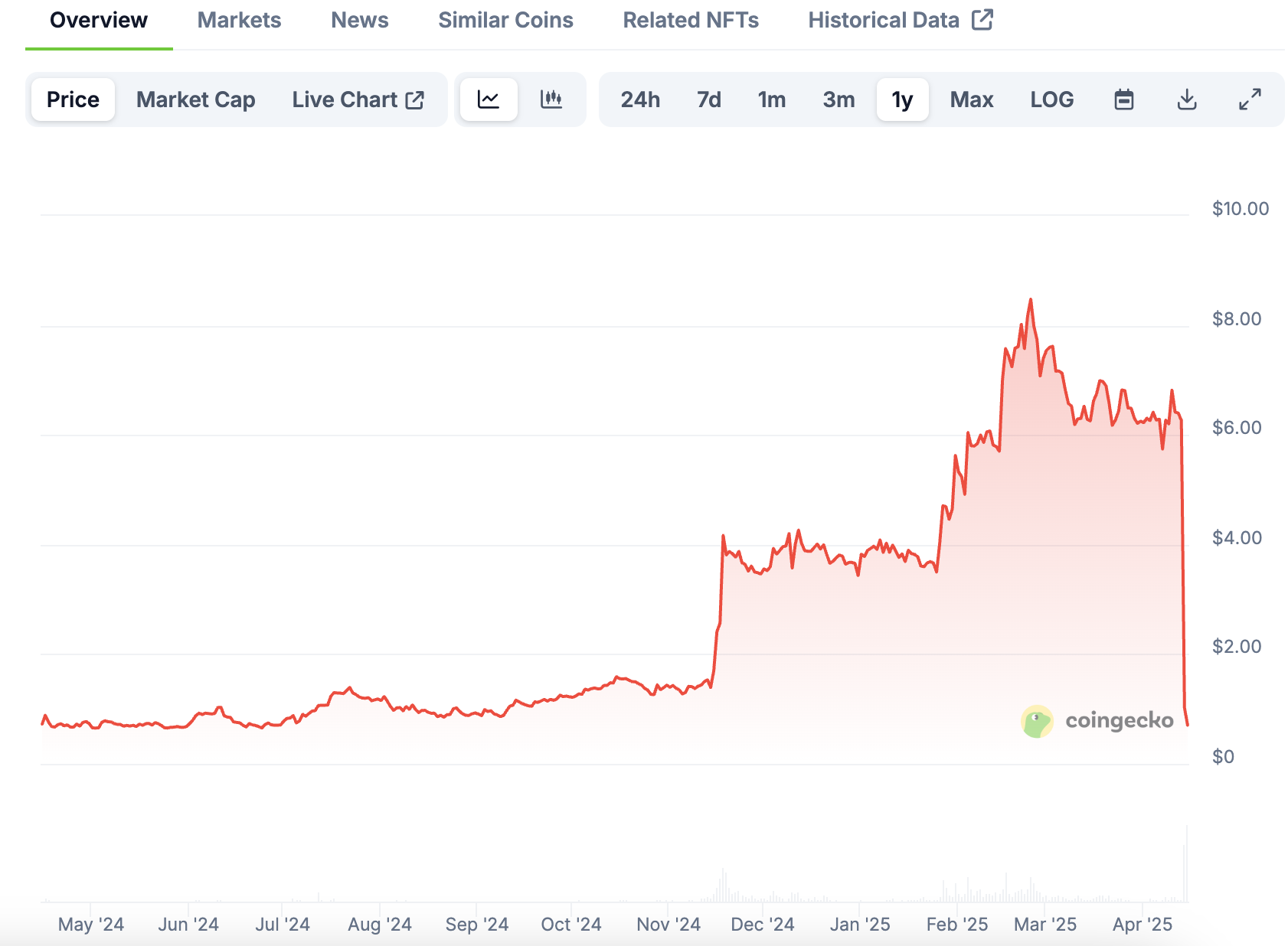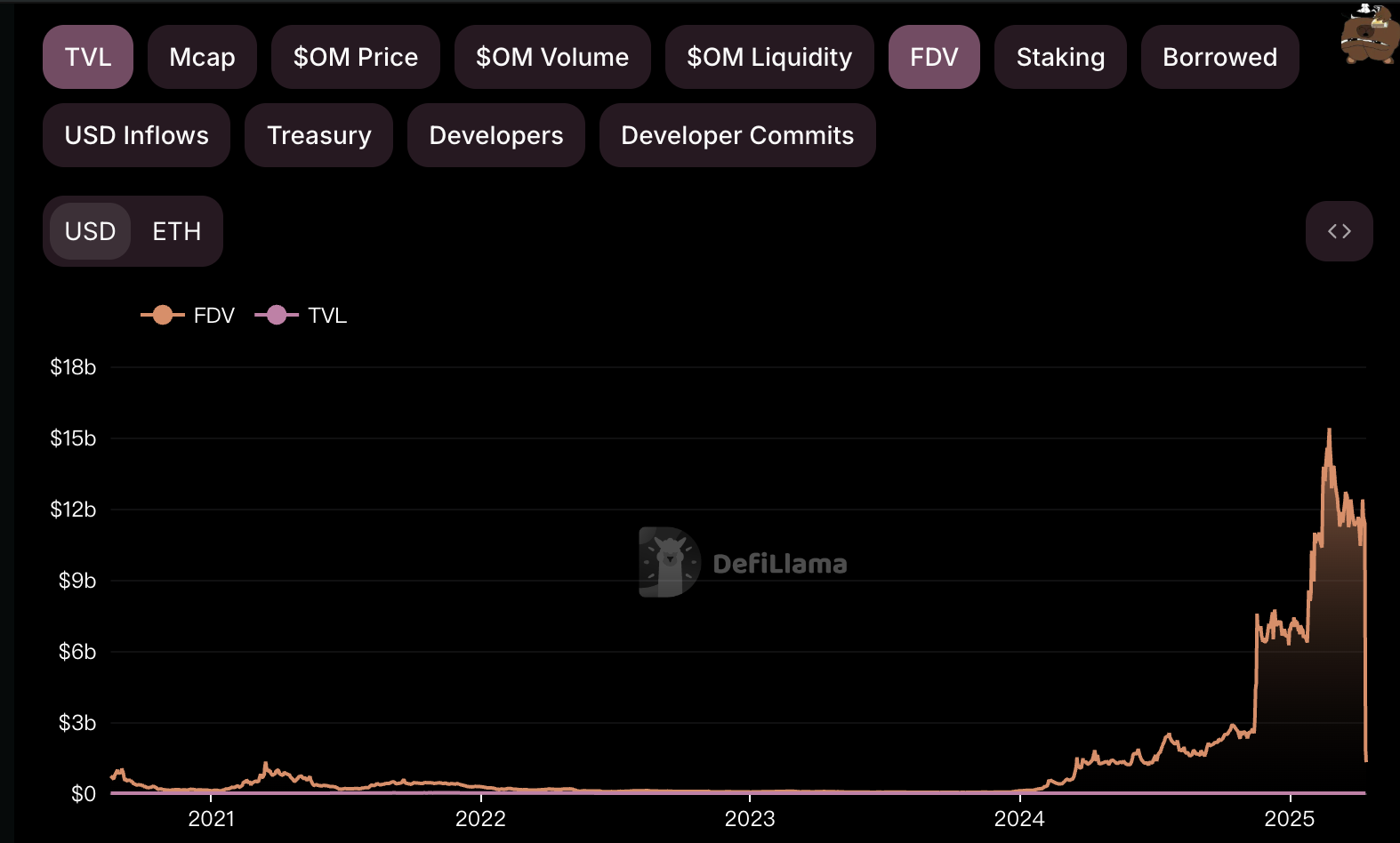Author: Nancy, PANews
With the support of RWA and violent manipulation, MANTRA once attracted a large number of investors. However, a thrilling price crash not only made MANTRA face the challenge of price fluctuations, but also exposed its complicated "black history", and brought about a crisis of trust and a test of governance.
OM crashed by nearly 90% late at night, with the project owner, exchange and investors each holding their own opinions
Behind the collapse of OM’s market value of tens of billions is a market storm caused by the interweaving of multiple factors.
In the early morning of April 14, the price of MANTRA token OM suddenly fell sharply. According to Coingecko data, the price of OM plummeted by 89.2% in the past 24 hours.

Regarding the flash crash of OM, MANTRA officials explained that the chaos was not caused by the team, MANTRA Chain Association, core consultants or MANTRA investors selling tokens. The tokens are still locked and subject to the announced vesting period. The token economics remain unchanged. Please do not click on any scam links or accounts impersonating MANTRA.
At the same time, the official pointed out that this incident occurred during a period of low liquidity, which may be due to negligence or market manipulation by the exchange. The time and depth of the plunge indicate that account positions were suddenly closed without sufficient warning or notification. This incident occurred on Sunday night UTC (early morning Asian time) during a period of low liquidity, indicating a certain degree of negligence on CEX, or perhaps a deliberate market positioning.
Binance confirmed in its statement that OM's recent price fluctuations were caused by "cross-exchange liquidation". Since October last year, a number of risk control measures have been implemented for OM tokens, including reducing leverage levels. Since January this year, Binance has added a pop-up warning for OM tokens on its spot trading page, reminding users that the token has made major adjustments to its token economics and increased the token supply. Binance said it will continue to pay close attention to the situation and take appropriate actions to protect users and maintain the integrity of the platform.
OKX pointed out in the announcement that since October 2024, the token economic model of OM has undergone major changes, and since early March, multiple on-chain addresses with similar operations have made large deposits and withdrawals on various exchanges. Based on market risks, OKX has adjusted the platform's risk control parameters and reminded users that the recent market risks are relatively high, and changes in the supply of some tokens may cause price fluctuations. A risk warning has been added to the OM token page. At the same time, OKX CEO Star said that this is a major scandal for the entire crypto industry. All on-chain unlocking and recharge data has been made public, and the collateral and liquidation data of all mainstream exchanges may be investigated. OKX will prepare all reports.
Although MANTRA placed the blame on exchanges, on-chain data pointed to a more complicated picture, raising questions in the community about potential insider selling and market manipulation.
According to Spot On Chain monitoring, 19 newly created wallets in March that were suspected to belong to the same entity transferred 14.27 million OM (about $91 million) to OKX at an average price of $6.375 in the three days before OM collapsed. According to The Data Nerd monitoring, in the past three days, 5 wallets have deposited a total of 24.4 million OM (about $143.94 million) into OKX. Four of the wallets have the same operating mode: withdrawing from Binance last month and then depositing into OKX; the other belongs to Laser Digital. According to Lookonchain monitoring, since April 7, at least 17 wallet addresses have deposited a total of 43.6 million OM tokens (worth about $227 million at the time) into the exchange, accounting for 4.5% of the circulating supply. At the same time, five hours before the OM token plummeted, a wallet that had been silent for a year transferred 2 million OM to the wallet of Shane Shin, the founding partner of Shorooq Partners, an investment institution of MANTRA. The wallet received 2 million OM at a price of $12.58 million, but now its value is only $1.57 million.
However, Laser Digital, a strategic investor in the MANTRA Chain project, responded that Laser had no connection to the recent drop in OM prices. The claims on social media that Laser was "related to investor selling" were false and misleading. Laser did not deposit any OM tokens with OKX, and the wallet mentioned as being associated with OKX was not Laser's wallet. Laser's core OM investment remains locked and has no interest in putting pressure on the token or destabilizing the project. Transparency is important.
Investment institution Shorooq Partners also issued a statement to clarify that the decline was not caused by a hacker attack or team selling, but was triggered by large-scale forced liquidation, followed by panic selling during low liquidity periods. Shorooq emphasized that its position as a long-term equity investor has not changed, and disclosed the relevant wallet addresses to prove transparency.
The project owner, the exchange, and the investors each have their own opinions. The deeper fuse of this plunge may be due to MANTRA's recent adjustment of the token economic model. Recently, MANTRA pointed out in an announcement that the community had previously proposed to unify OM as the native token of the main network and abolish the two-currency strategy, but it also brought technical challenges. For this reason, the team decided to abandon the original ERC-20 OM and establish OM on the MANTRA Chain as the standard version. At the same time, MANTRA announced that it would double the supply of OM from 888.8 million to 1.7777 billion, and introduce a 3% annual inflation rate to incentivize staking. Although this move is intended to support ecological growth, the significantly increased circulation and unlimited inflation mechanism are believed to have weakened investor confidence.
It is worth mentioning that although OM has fallen sharply, large-scale token selling is still continuing. According to the latest monitoring by Onchain Lens (@OnchainLens), MANTRA DAO staking wallet sent 38 million OM (about 26.96 million US dollars) to Binance cold wallet.
It was involved in scam controversy in the early days, and the high degree of control and narrative trap behind the surge
MANTRA's predecessor was MANTRA DAO, which was founded in 2020 and initially focused on staking, lending, and asset management services. However, MANTRA DAO was considered a scam in the early days with popular labels such as DeFi and Polkadot. According to previous reports by Wu Blockchain and Honeycomb Finance, the core team and consultants of Mantra DAO have suspicious backgrounds, identity fraud, and even a history of fraud, including the controversial background of founder Calvin Ng, who has close ties to the online gambling site 21Pink. At the same time, the project's technology and functions had not yet been implemented, but Mantra DAO relied on marketing methods and false partnerships to attract investment.
Not only that, MANTRA has also been caught up in a lawsuit due to internal disputes. In early 2022, RioDeFi filed a lawsuit against MANTRA DAO, accusing it of ownership, management and asset misappropriation issues. RioDeFi said that it founded and developed MANTRA DAO in 2020, but the MANTRA DAO core team (including co-founder John Patrick Mullin and six others) stopped financial reporting after 2021, misappropriated assets and controlled the project without authorization. MANTRA DAO argued that as a DAO, it is governed by OM token holders, not RioDeFi. In August 2024, the Hong Kong High Court intervened and ordered key figures in MANTRA DAO to disclose financial records in response to allegations of asset misappropriation and unauthorized control. This case became the world's first judicial review of DAO ownership and governance.
In 2022, MANTRA DAO announced that it would officially change its name to MANTRA and initiated a brand reorganization, indicating that it was trying to transform from a decentralized autonomous organization (DAO) to a broader blockchain ecosystem. Since 2024, MANTRA has attracted much attention due to the strong pull of OM. CoinGecko data shows that in 2024 alone, OM rose by more than 168.8 times. At the same time, DeFiLlama data shows that OM's fully diluted valuation (FDV) once reached US$15.39 billion in March this year, and has now fallen sharply to US$1.25 billion. However, in sharp contrast to its high valuation, since 2023, OM's total locked value (TVL) has been at a low level for a long time, maintaining only at the level of hundreds of thousands of dollars.

The high degree of control by the project team and the support of the RWA narrative craze are considered to be the important reasons for the rise of OM. On the one hand, according to the recent disclosure by crypto analyst Mosi, the MANTRA team holds 90% of the "circulating volume" of OM tokens, and the actual market circulation accounts for only 5% of the fully diluted valuation (FDV).
However, the highly controlled strategy also planted the bomb of concentrated chips and fragile liquidity. According to Rui, a member of HashKey Capital, MANTRA is a local OTC market, with a scale of at least US$500 million in two years, and it operates in a cycle of "new OTC tokens take over old OTC selling orders" until the last unlocked chips "OTC does not move" explode.
On the other hand, MANTRA has been active in the RWA track, releasing a series of positive signals, including the establishment of a $109 million ecosystem fund, cooperation with the UAE DAMAC Group, plans to tokenize $1 billion in assets, the introduction of Google as a validator and infrastructure provider to cooperate in the RWA accelerator, and tokenization of Dubai MAG Group's $500 million worth of real estate assets.
The involvement of Middle Eastern capital was a turning point in the development of MANTRA. According to ArkStream Capital Founding Partner Ye Su, in 2023, when the OM token FDV fell to US$20 million and was almost abandoned, a Middle Eastern capital intervened in the acquisition under the matchmaking of an intermediary, retaining only the position of CEO. The Middle Eastern capital owns a large number of physical assets such as luxury homes and resorts, and then packaged OM into a physical asset tokenization (RWAfi) project. Ye Su said that under a high degree of control, OM set Binance's highest increase in 2024, achieving a 200-fold increase, and the team is still promoting the OTC business recently.
Public information also shows that MANTRA co-founder and CEO John Patrick Mullin, co-founder Jayant Ramanand, CTO Matthew Crooks and other senior executives have all resigned. And the financing background shows that MANTRA announced in March 2024 that it had received $11 million in financing led by Shorooq Partners. It is understood that Shorooq Partners is a leading venture capital and alternative investment management company headquartered in Abu Dhabi, focusing on technology startups in the Middle East, North Africa and Pakistan (MENAP) region. After announcing the investment from Shorooq Partners, MANTRA launched an incubator at the Dubai World Trade Center, focusing on RWA tokenization projects in the Middle East and North Africa.
Overall, multiple factors such as the shadow of unresolved early disputes, the highly controlled token economy, the behind-the-scenes manipulation of capital, and the promotion of the RWA narrative heat together constitute the multiple footnotes of this tragic collapse.















